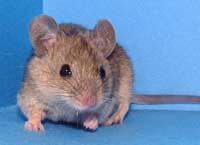Strain Data Sheet
RBRC00208
Strain Information | |
|---|---|
| Image |  |
| BRC No. | RBRC00208 |
| Type | Wild-derived strain, partially inbred |
| Species | Mus spretus |
| Strain name | M. spretus |
| Former Common name | M. spretus |
| H-2 Haplotype | |
| ES Cell line | |
| Background strain | SPR2 [Mus spretus] |
| Appearance | white-bellied agouti [Aw/Aw , B/B, C/C] |
| Strain development | 米国Roswell Park Cancer Institute、Rosemary Elliott博士より寄託。ランダム交配コロニーとして導入し、その後、理研実験動物開発室で近交系化が開始された。現在CV+F3世代、SPF+20世代を経る。維持は通常の兄妹交配により行う。通常,同腹仔の場合は離乳と同時に交配を行う。同腹仔以外の場合は雄8-12週齢,雌4-8週齢(交配未経験の場合)で繁殖に供用するとよい。動物の健康管理に心がけ,育成環境の統一を図るために,ケージ収容匹数を一定に保つ。野生由来系統であるため、動きが激しく、素早いため、取り扱いには注意する。とりわけ、ケージ網につかまることが多いため、マウス移動時には注意を必要とする。巣箱を使用すると繁殖性が向上する。交配成功率:90%初産日齢:76.9±13 (mean ±SD)平均産仔数:5.0±1.6 (mean ±SD) |
| Strain description | 西地中海周辺、イベリア半島、南フランス、北アフリカに生息するMus spretusに属する。米国Roswell Park Cancer Institute、Rosemary Elliott博士より寄託。皮膚ガンの誘発実験では抵抗性遺伝子を持つ。近交系マウスと交配した雑種第1世代は雄のみが不妊となる。近交系マウスとの遺伝的な隔たりを利用した染色体地図の作製や、遺伝学研究、生殖研究、ゲノム遺伝子のインプリンティングの研究に用いられている。 |
| Colony maintenance | Sibling x Sibling. |
| References | Biochem. Genet., 16(3-4):213-225 (1978). 678291 |
Health Report | |
|---|---|
| Examination Date / Room / Rack | 2024/02/26Room:4-CRack:E 2023/11/27Room:4-CRack:E 2023/08/28Room:4-CRack:E 2023/05/29Room:4-CRack:E 2023/02/27Room:4-CRack:E 2022/11/29Room:4-CRack:E 2022/08/29Room:4-CRack:E 2022/05/31Room:4-CRack:E |
Gene | |
|---|---|
| Gene info | |
Ordering Information | |
|---|---|
| 供与核酸 | |
| Research application | Genetics Research Reproductive Biology Research |
| 提供条件 | 条件を付加しない。 |
| Depositor | Roswell Park Cancer Inst.(Roswell Park Cancer Inst.) |
| Strain Status |  生体 生体 凍結胚 凍結胚 凍結精子 凍結精子 |
| Strain Availability | 凍結精子を1ヶ月以内に提供可能 凍結胚を1ヶ月以内に提供可能 生体マウスを1~3ヶ月以内に提供可能 |
| Additional Info. | Necessary documents for ordering:
Click Here for Mouse genomic DNA (RIKEN DNA Bank) |
BRC mice in Publications |
|---|
Kawakami M, Yamamura K. Cranial bone morphometric study among mouse strains. BMC Evol Biol 8 73(2008) 18307817 Hasegawa A, Mochida K, Matoba S, Inoue K, Hama D, Kadota M, Hiraiwa N, Yoshiki A, Ogura A. Development of assisted reproductive technologies for Mus spretus†. Biol Reprod 104(1) 234-243(2021) 32990726 Kono H, Tamura M, Osada N, Suzuki H, Abe K, Moriwaki K, Ohta K, Shiroishi T. Prdm9 polymorphism unveils mouse evolutionary tracks. DNA Res 21(3) 315-26(2014) 24449848 Oka A, Mita A, Takada Y, Koseki H, Shiroishi T. Reproductive isolation in hybrid mice due to spermatogenesis defects at three meiotic stages. Genetics 186(1) 339-51(2010) 20610405 Kaneko S, Aki I, Tsuda K, Mekada K, Moriwaki K, Takahata N, Satta Y. Origin and evolution of processed pseudogenes that stabilize functional Makorin1 mRNAs in mice, primates and other mammals. Genetics 172(4) 2421-9(2006) 16415359 Johnsen JM, Levy GG, Westrick RJ, Tucker PK, Ginsburg D. The endothelial-specific regulatory mutation, Mvwf1, is a common mouse founder allele. Mamm Genome 19(1) 32-40(2008) 18188647 Hirotsune S, Yoshida N, Chen A, Garrett L, Sugiyama F, Takahashi S, Yagami K, Wynshaw-Boris A, Yoshiki A. An expressed pseudogene regulates the messenger-RNA stability of its homologous coding gene. Nature 423(6935) 91-6(2003) 12721631 Aizawa S, Nishimura K, Mondejar GS, Kumar A, Bui PL, Tran YTH, Kuno A, Muratani M, Kobayashi S, Nabekura T, Shibuya A, Sugihara E, Sato TA, Fukuda A, Hayashi Y, Hisatake K. Early reactivation of clustered genes on the inactive X chromosome during somatic cell reprogramming. Stem Cell Reports 17(1) 53-67(2022) 34919813 |